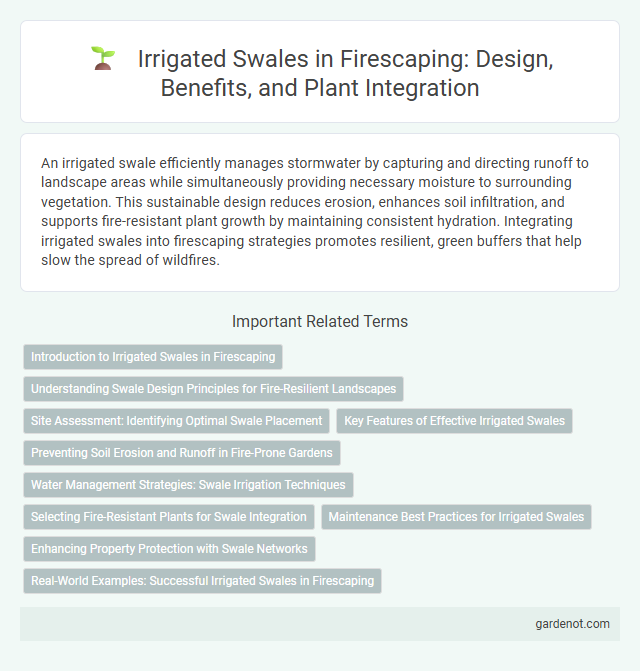An irrigated swale efficiently manages stormwater by capturing and directing runoff to landscape areas while simultaneously providing necessary moisture to surrounding vegetation. This sustainable design reduces erosion, enhances soil infiltration, and supports fire-resistant plant growth by maintaining consistent hydration. Integrating irrigated swales into firescaping strategies promotes resilient, green buffers that help slow the spread of wildfires.
Introduction to Irrigated Swales in Firescaping
Irrigated swales are landscaping features designed to manage stormwater runoff while enhancing fire-resistant vegetation growth in firescaping. These shallow, elongated depressions capture and slow water flow, allowing infiltration that supports fire-safe plants and reduces dry vegetation fuel. Integrating irrigated swales into firescapes improves soil moisture, creating natural firebreaks that mitigate wildfire risks around properties.
Understanding Swale Design Principles for Fire-Resilient Landscapes
Irrigated swales in firescaping utilize gentle, contoured trenches that capture and direct stormwater, promoting deep soil moisture to support fire-resistant vegetation. Proper swale design includes managing slope gradients and soil permeability to maximize water infiltration, reducing fuel loads and fire intensity near structures. Integrating native, drought-tolerant plants within these swales enhances landscape resilience by maintaining moisture barriers that slow wildfire spread.
Site Assessment: Identifying Optimal Swale Placement
Identifying optimal swale placement requires thorough site assessment, including topography analysis, soil infiltration rates, and existing vegetation patterns to ensure effective water capture and fire risk reduction. Assessing slope orientation and drainage patterns helps determine natural water flow, minimizing erosion and promoting healthy plant growth within the swale. Incorporating these factors in firescaping design enhances irrigation efficiency and creates defensible spaces that reduce wildfire hazards.
Key Features of Effective Irrigated Swales
Effective irrigated swales incorporate gentle, sloped channels designed to capture and direct runoff water efficiently, promoting deep soil infiltration and reducing erosion. They integrate drought-tolerant, fire-resistant vegetation strategically planted to enhance moisture retention while minimizing fire fuel load. Subsurface irrigation systems often support consistent soil hydration, ensuring plant health and resilience during dry periods in high fire risk landscapes.
Preventing Soil Erosion and Runoff in Fire-Prone Gardens
Irrigated swales are essential for preventing soil erosion and managing runoff in fire-prone gardens by slowing water flow and enhancing infiltration, which stabilizes soil and reduces sediment displacement during heavy rains. These landscape features capture and direct irrigation water efficiently, promoting deep root growth that strengthens plant resilience against fire damage. Proper installation of irrigated swales minimizes fire hazards by maintaining moist soil conditions and limiting the spread of flammable debris downhill.
Water Management Strategies: Swale Irrigation Techniques
Irrigated swales enhance water management by capturing and directing runoff to vegetation, promoting deep soil infiltration and reducing erosion. Employing contour-aligned swale irrigation techniques maximizes water retention, supports plant health, and mitigates wildfire risks. Integrating permeable materials and overflow outlets further optimizes water distribution and prevents saturation during heavy rainfall.
Selecting Fire-Resistant Plants for Swale Integration
Irrigated swales provide an ideal environment for fire-resistant plants by maintaining consistent moisture levels that reduce wildfire risks. Selecting native drought-tolerant species such as manzanita, ceanothus, and toyon enhances both erosion control and fire resilience within swale systems. Integrating these plants helps establish defensible spaces, minimizing fuel loads and improving overall landscape safety in fire-prone areas.
Maintenance Best Practices for Irrigated Swales
Regular inspection and clearing of debris in irrigated swales prevent water flow obstruction and erosion, ensuring effective firebreak functionality. Mulching around vegetation helps retain soil moisture while suppressing weeds that could fuel wildfires. Scheduling irrigation during cooler parts of the day minimizes water loss and supports plant health, maintaining a resilient landscape barrier against fire spread.
Enhancing Property Protection with Swale Networks
Irrigated swale networks significantly enhance property protection by managing stormwater runoff and reducing wildfire risks through moisture retention in strategic landscape contours. These swales create natural firebreaks and promote vegetation health by directing water to drought-prone areas, thereby lowering fuel loads near structures. Effective design integrates soil permeability and gradient to maximize infiltration, supporting resilient, fire-adaptive landscapes.
Real-World Examples: Successful Irrigated Swales in Firescaping
Irrigated swales have proven effective in reducing wildfire risks in fire-prone regions such as California's Sierra Nevada and Australian bushlands, where they slow water runoff and maintain vegetation moisture. Projects like the Mt. Shasta Firescaping Initiative demonstrate how integrating swales with native, fire-resistant plants creates natural firebreaks that enhance landscape resiliency. These real-world implementations highlight the importance of soil moisture management and erosion control in strategic firescaping design.
Irrigated swale Infographic

 gardenot.com
gardenot.com